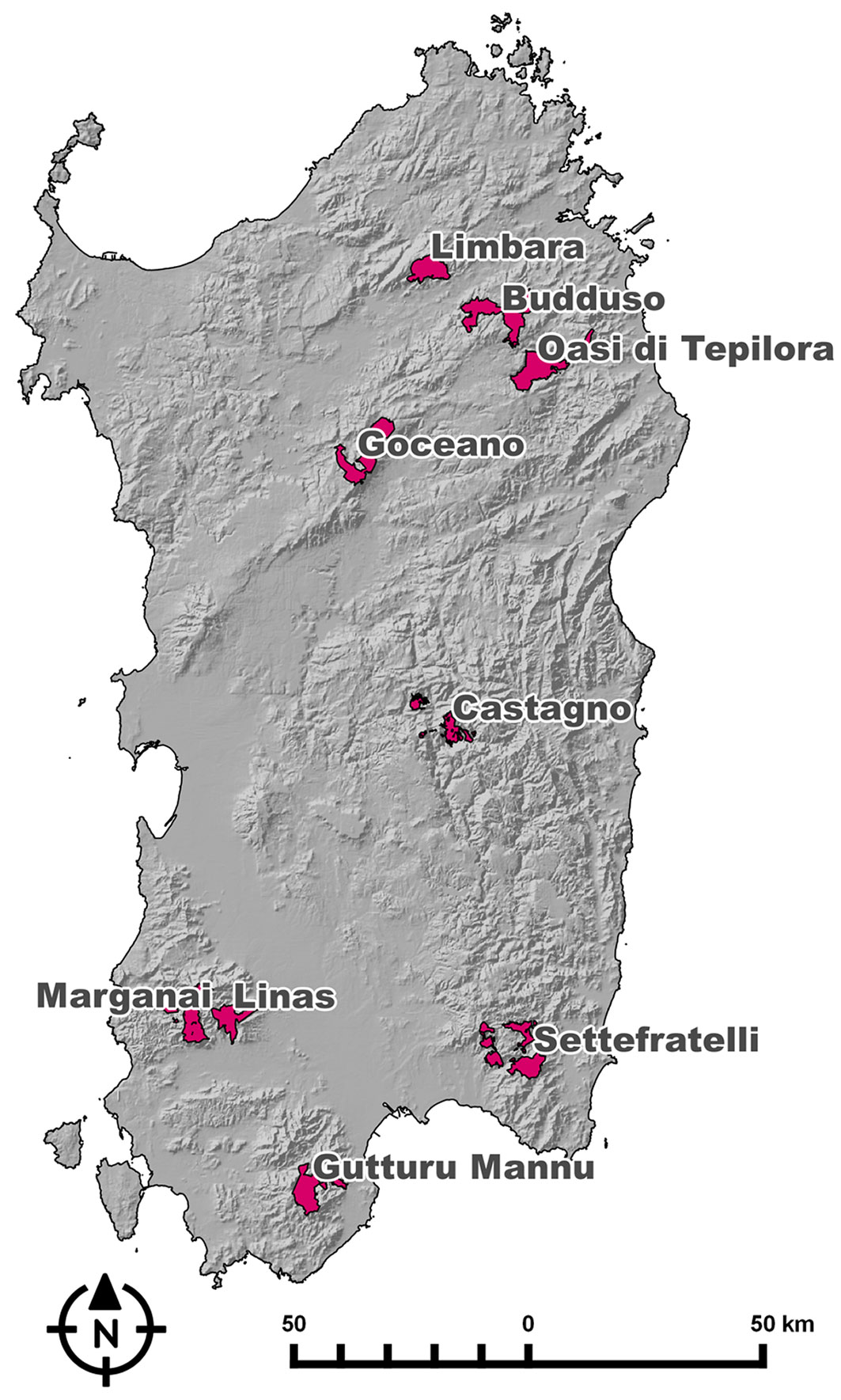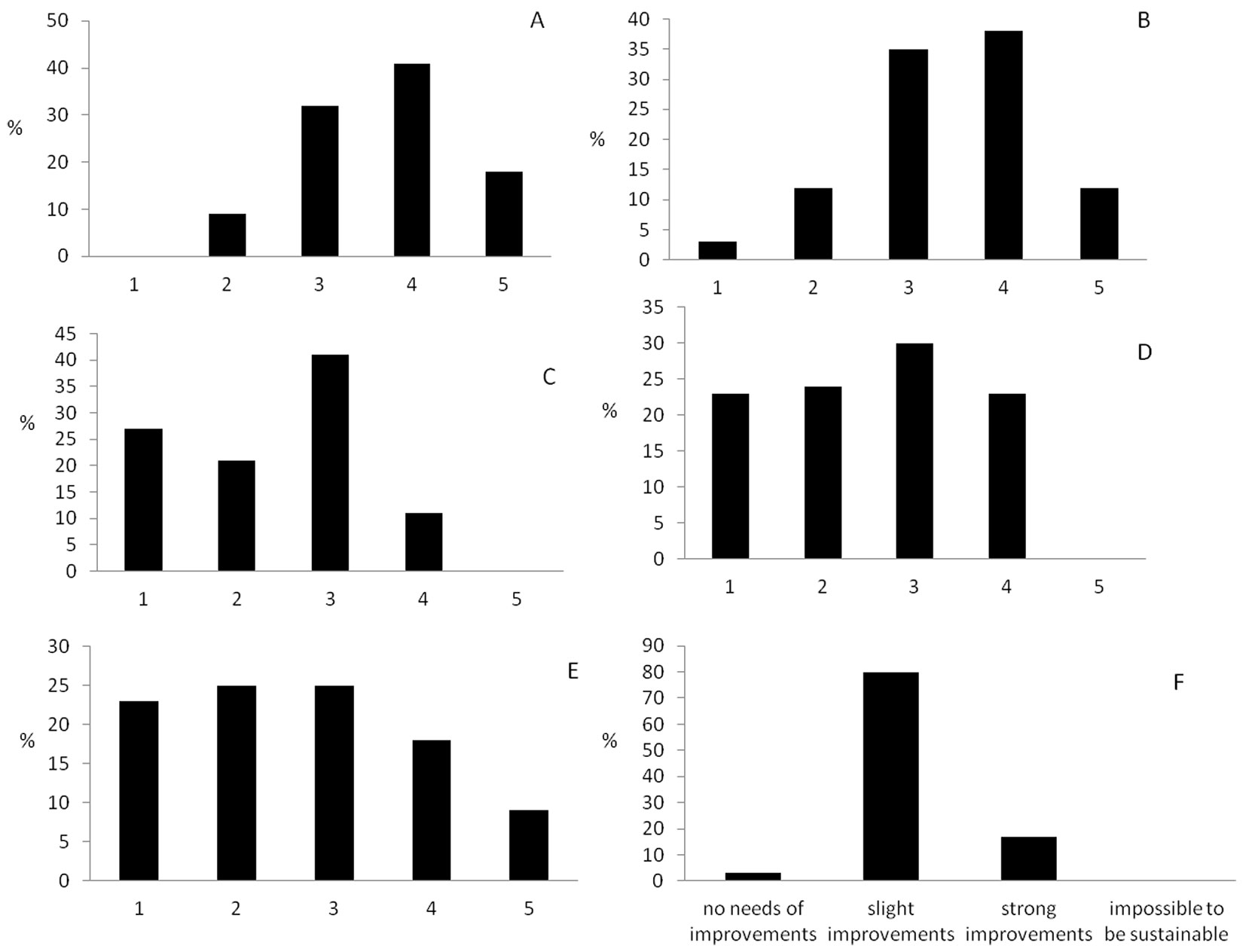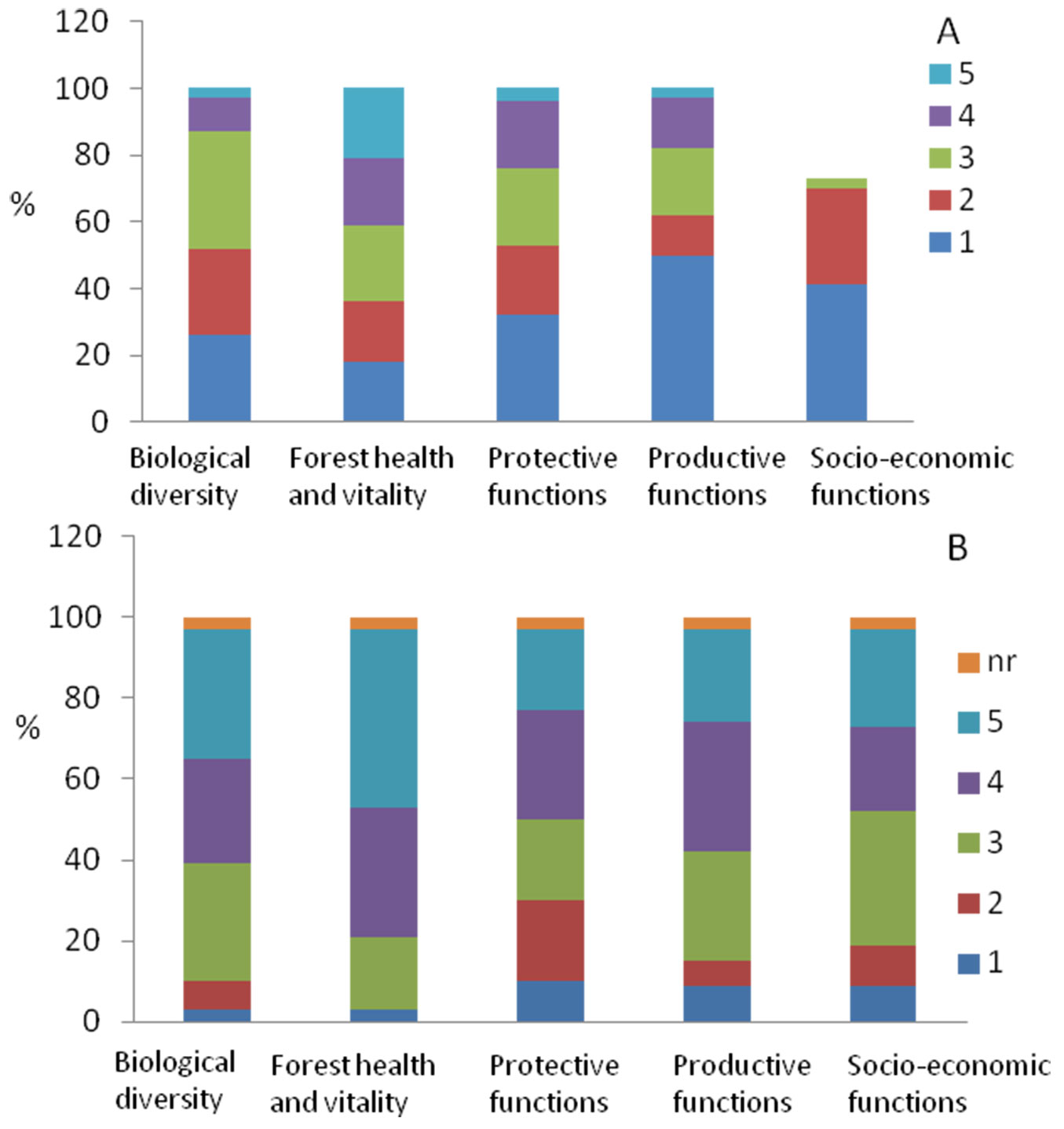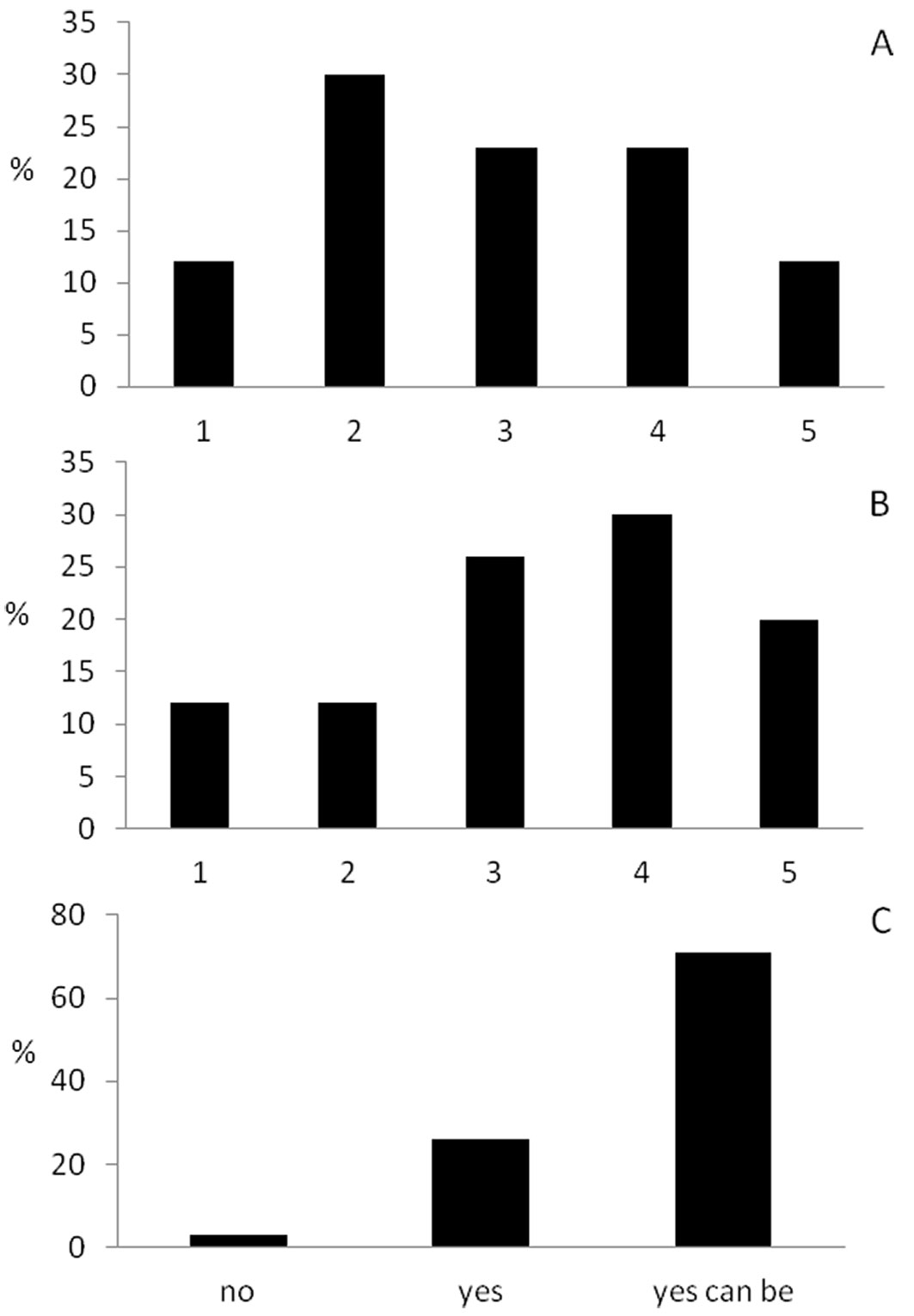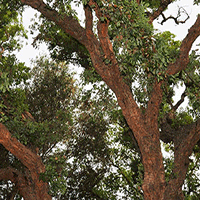
Indicators for the assessment and certification of cork oak management sustainability in Italy
iForest - Biogeosciences and Forestry, Volume 11, Issue 5, Pages 668-674 (2018)
doi: https://doi.org/10.3832/ifor2587-011
Published: Oct 04, 2018 - Copyright © 2018 SISEF
Research Articles
Collection/Special Issue: INCOTW - Sassari, Italy (2017)
International Congress on Cork Oak Trees and Woodlands
Guest Editors: Piermaria Corona, Sandro Dettori
Abstract
Sustainable forest management (SFM) is crucial for forest ecosystem productivity and conservation, especially in systems such as cork oak (Quercus suber L.) threatened by human activities and biotic and abiotic factors. In this study SFM indicators with particular reference to cork oak forests in the region of Sardinia (Italy) are proposed and tested. Sustainable and responsible management options specifically aimed at cork oak forest management and chain of custody certification are also provided. A set of ten indicators was proposed and assessed by an expert panel in cork oak management. Five indicators were also tested against data on structure, origin, health condition and management in 285 forest compartments managed by FoReSTAS (Regional Forest Agency for Land and Environment of Sardinia, Italy), including 361 sampling plots and 5345 trees. In order to investigate the priorities and perceptions of SFM experts and stakeholders, a survey was also carried out by completion of a questionnaire on the technical issues of cork oak woodland management. The survey results highlighted a need to improve environmental and economic performance by means of SFM and certification. The indicators tested in Sardinian cork oak woodlands showed that about 80% of the stands fulfilled management sustainability requirements. The suggested SFM indicators can effectively support proactive management and conservation measures, representing a valuable tool in the current context of growing environmental and socioeconomic awareness.
Keywords
Quercus suber, Sustainable Forest Management, Forest Management Planning, Non-wood Forest Products, Sardinia, Italy
Introduction
The concept of sustainability has been used for decades in forestry to ensure that the exploitation of forest resources does not exceed growth levels and provides a regular long-term production of wood and non-wood goods. The term “sustainable forest management” (SFM) was defined in Europe in 1993 (Helsinki Resolution H1 - [25]) and is crucial for the conservation of biodiversity and other ecosystem services, and it is a “key pillar of rural development” ([21]). Forest certification is a market-based conservation tool based on a third-party assessment of compliance with sustainable environmental and socio-economic management standards. SFM is particularly important in Mediterranean forest ecosystems, such as cork oak (Quercus suber L.) woodlands, where a strong human influence, related to past and present management activities, has shaped forest structure, productivity, species diversity, evolution and regeneration ([29]).
Human management of cork oak woodlands has favored habitat heterogeneity and biodiversity at local and regional levels. The open canopy structure, where tree density may be as low as 60 trees per hectare, and the shrubland-grassland mosaic of managed cork oak forests, intermixed with the closed canopy of evergreen trees, favor high plant and animal species richness. Cork oak savanna-type ecosystems (named montado, dehesa, azaghar, pascolo arborato, meriagos in Portugal, Spain, North Africa, Italy and Sardinia, respectively) are protected under the Pan-European network of protected areas (Natura 2000) and defined as “biodiversity-based product systems” by the Convention on Biological Diversity. Cork oak woodlands are characterized by a structure that may be referred to as “one system, multiple land uses” ([9]), i.e., jointly delivering various provisioning, regulating and cultural services ([29]).
Cork oak is an evergreen species mainly distributed in the Western Mediterranean basin, from the Iberian peninsula (Portugal, Spain) and North Africa (Morocco, Algeria, Tunisia) to Corsica and Italy, covering 2.1 million hectares ([3]). In Italy cork oak forests cover a total of 186,344 ha (1.78 % of the total forest area - [23]), of which 168,602 ha are cork oak-dominated high forests and 17,742 ha open formations, with small groups of cork oak trees mixed with other tree species. At the sub-national level, cork oak woodlands are mainly concentrated in Sardinia, where they cover 139,489 ha ([23]) and can be classed as pure stands with more than 25% canopy cover (80,489 ha - [34]) and mixed stands (57,934 ha) with 5-25% canopy cover, where cork oak is the dominant species associated with other tree species and with agro-silvopastoral systems. The third cork oak forest type, according to [23], is represented by broadleaf forests with a sporadic presence of cork oak trees (489,877 ha in Sardinia). In Italy, cork oak forests are also present in Tuscany (6,142 ha concentrated along the Tyrrhenian coast), Latium (2,211 ha), Calabria (4,851 ha) and Sicily (15,541 ha - [23]).
Features and management of cork oak ecosystems are dependent on the distinctive trait of cork oak, i.e., its bark. In Italy, cork collection is practised at 9-12 year intervals, corresponding to the average time necessary for the trees to produce a new bark layer approximately 30-40 mm thick. Cork yield is determined by the circumference of the tree stem, the harvesting frequency and the length of stem and main branches that can be stripped. In Italy the first cork harvest is carried out when the tree is approximately 30-50 years old or when it reaches a conventional size (60 cm of stem circumference over the bark at 1.30 m of height, according to the national law n.759/1956 and the regional law in Sardinia - [33]). In the western Mediterranean basin 300,000 tons of cork are harvested annually, 70% of which is transformed into bottle stoppers ([4], [10]). Other minor products include floor and wall tiles, insulation material, sound-proofing in the car industry, special devices for the space industry, accessories or handicrafts.
The conservation and restoration of cork oak woodlands and implementation of sustainable management actions may be addressed by means of market tools such as “payment for ecosystem services” and/or certification of forest management and chain of custody (CoC, i.e., the pathway that leads from raw materials, through processing to final products, from the forest to the consumer), such as the Forest Stewardship Council (FSC) and Programme for the Endorsement of Forest Certification (PEFC) schemes. FSC certification for cork oak forest management is currently adopted in Portugal, Spain and Italy with 357,386, 159,695 and 66 certified hectares, respectively ([18]), and is underway in Morocco and Tunisia. PEFC certification currently applies in cork oak forests in Portugal and Spain, for 109,058 and 21,000 ha, respectively ([8]). In Italy three public forests (over 8.000 ha, including cork oak woodlands) managed by the Regional Forest Agency for Land and Environment of Sardinia (FoReSTAS) were FSC-certified for forest management and CoC of firewood in the years 2011-2014. The only forest with a valid FSC certificate in Sardinia since 2010 is represented by 66 ha of semi-natural cork forests owned by the public agency AGRIS Sardegna, Department of Research for cork and silviculture, located in Tempio Pausania (province of Olbia-Tempio). For PEFC, a private forest (20 ha) owned by Società Agricola Limbara s.r.l. of Calangianus (Olbia-Tempio) was certified for the years 2008-2013 ([31]).
Certification may provide an added value to the final products, while safeguarding commercial rights of local communities and increasing economic benefits. However, limited knowledge on sustainable cork oak management practices hinders the application of good practices and SFM indicators. In this light and with a view to filling these knowledge gaps, this study aimed to: (i) propose a set of SFM indicators specifically targeting cork oak forests using structural, management and economic information obtained from forest management plans in Sardinia; (2) define sustainable and responsible cork oak woodland management options and strategies oriented towards cork oak forest management and CoC certification.
Material and methods
Development of the indicators
A set of ten SFM indicators specific for cork oak forests was defined (Tab. S1 in Supplementary material) and tested using data and information on structure, origin, health condition and management of cork oak stands obtained from the forest management plans of FoReSTAS’ estates (2014).
The indicators proposed for cork oak forests were conceived as forest management “performance indicators”, referred to aspects for which binding thresholds (standard values) of forest management sustainability were applied. All the indicators proposed, along with the relative thresholds were partly derived from the literature ([13], [6], [2], [15], [32], [27], [11]), technical guidelines ([20], [22], [31]) normative references ([33]), and checked and discussed by a panel of experts in SFM, cork oak management, forest certification, cork production, forest resources’ protection and conservation, working in both public and private sectors.
The indicators were identified by taking into account the management issues and ecological features of cork oak woodlands. The feasibility of obtaining indicators from management planning data was also assessed.
Questionnaire survey
A survey to investigate the perception and priorities of stakeholders and experts on cork oak woodlands SFM was carried out. A questionnaire was drawn up and distributed to national and international stakeholders. Eleven questions concerning SFM and technical information on management of cork oak stands, plus two questions on the education level and professional specialization of the interviewees, were asked. The respondents were asked to express their preference on the issues considered, by ranking the answers. The questionnaire was presented at the International Congress on Cork Oak Trees and Woodlands and 3° National Congress of Cork (25-26 May 2017, Sassari, Italy) and was completed anonymously either on paper or online. A total of 34 persons responded to the questionnaire. The respondents (23 males and 11 females) were from Italy, Portugal and Spain. Concerning their job positions, 10 were officials/technologists, 18 researchers/scientists and 6 technicians. They were all (except one person) experienced and specialized in SFM; 28 persons usually and/or occasionally work in cork oak management, while 6 were only theoretically well-informed and/or inexperienced on this specific issue.
Field test
A sub-set (five) of indicators were tested in nine Sardinian forests (Fig. 1), including cork oak woodlands managed by the public agency FoReSTAS, for a total of 2267 ha of cork oak forests (Tab. 1). The sub-set of indicators was tested in 285 forest compartments (2% of the Sardinian cork oak forests), on 361 sampling plots (circular plots with radius of 13 m) for a total of 5345 cork oak trees surveyed. The indicators tested were: first (indicator 3.1) and next (indicator 3.2) extraction height; minimum circumference at 1.30 m of height (CBH) for the first cork extraction (indicator 4); age/size classes (indicator 9.1); vegetation cover (indicator 9.2). Indicators 3.1, 3.2 and 4 were assessed at tree and sampling plot levels, while indicators 9.1 and 9.2 were assessed at the compartment level.
Tab. 1 - Structural and management characteristics of the forests used to test a subset of SFM indicators of specific for cork oak forests in Sardinia. (Mean CBH): mean stem circumference at breast height (1.30 m above ground); (Regeneration): regeneration of the stands, which can be natural, either by seed or agamic (i.e., through sprouts after cutting), artificial (planting) or both (mixed). (Average slope): assessed by weighted mean over areas with different slope within the considered stand; (Cork production): low <100 kg ha-1yr-1; average, 100-200 kg ha-1yr-1; high >200 kg ha-1yr-1.
| Forest district |
Municipality | Cork oak forest area (ha) | Cork oak density (tree ha-1) | Mean CBH (cm) | Mean height (m) | Regeneration | Average canopy cover (%) | Average slope (%) | Cork production |
|---|---|---|---|---|---|---|---|---|---|
| Buddusò | Alà dei Sardi, Monti, Berchidda, Buddusò | 338 | 425 | 67.2 | 6.22 | mixed | 43.9 | 12.9 | high |
| Castagno | Aritzo, Tonara, Belvì, Sorgono | 142 | 620 | 96 | 8.08 | natural | 67 | 37.3 | average |
| Goceano | Bono, Bottida, Anela, Bultei | 644 | 735 | 80 | 6.39 | natural (agamic) | 71.6 | 18.6 | average |
| Gutturu Mannu | Pula, Villa San Pietro, Domus de Maria, Sarroch | 21 | 610 | 72.3 | 6.59 | artificial | 60 | 28.1 | high |
| Limbara | Berchidda | 273 | 630 | 55.1 | 5.31 | natural | 41.4 | 30.3 | high |
| Linas | Villacidro, Iglesias, Domuisnovas, Gonnosfanadiga | 315 | 710 | 55.2 | 4.85 | artificial | 56.2 | 32.1 | low |
| Marganai | Dosmunovas, Iglesias e Fluminimaggiore | 41 | 1240 | 70 | 7.81 | mixed | 87.5 | 30.0 | low |
| Oasi di Tepilora | Bitti, Alà dei Sardi, Torpé | 194 | 620 | 64.7 | 5.60 | mixed | 63.3 | 20.3 | low |
| Settefratelli | Burcei, San Vito, Sinnai | 299 | 1135 | 49 | 5.05 | mixed | 67.7 | 29.3 | average |
Results
Survey on SFM of cork oak woodlands
The results of the questionnaire are shown in Fig. 2, Fig. 3 and Fig. 4. The need to improve the environmental quality of cork oak stands and to increase their economic revenue by means of SFM certification is highlighted (Fig. 2B and Fig. 2F). Important limiting factors for cork extraction are forest health and vitality and the protective functions of forests (20% of the responses quote “moderately limiting factor” - Fig. 3A). The general perception on the current conditions of cork oak woodlands is that they need slight improvement to achieve management sustainability (80% of the responses - Fig. 2F). The main criteria to achieve this goal are to improve forest health and vitality (44% of responses as “very important” - Fig. 3B), biological diversity (32% of responses as “very important”) and socio-economic functions of cork oak stands (24% of responses as “very important”). A reduction in cork extraction height below 2.5 times the CBH (Fig. 2C) and an increase in the CBH over 60 cm for the first cork extraction (Fig. 2D) are considered to slightly improve the sustainability of the management. The use of only natural regeneration is considered to improve management sustainability (Fig. 2E), as well as an increase of understory cover (Fig. 4A) and limitation of mechanical operations in stands with a slope higher than 15% (Fig. 4B). Finally, heterogeneous stand structures (Fig. 4C) are perceived as relatively more sustainably managed than homogenous ones.
Fig. 2 - Results of the questionnaire on SFM of cork oak forests. Panels (A to F) show the percentage given to each answer type by national and international stakeholders to the following questions: (A) “To what extent can SFM certification of cork oak forests increase environmental quality?”; (B) “To what extent can SFM certification of cork oak forests increase economic revenues?”; (C) “Reduction in cork extraction height below 2.5 times the CBH improve management sustainability?”; (D) “Can the increase of CBH over 60 cm for the first cork extraction improve management sustainability?”; (E) “Can exclusive use of natural regeneration improve management sustainability?”; (F) “Is cork oak management already sustainable?”. Under (A-E), (1): cannot improve; (2): improves; (3): slightly improves; (4): moderately improves; (5): strongly improves.
Fig. 3 - Results of the questionnaire on SFM of cork oak forests. Panels (A, B) show the percentage of answers given by national and international stakeholders to the following questions: (A) “Which of the following SFM criteria are limiting factors for cork extraction?”; (B) “Which of the following SFM criteria are important factors to make cork oak management more sustainable?”. Under (A), (1): not limiting; (2): limiting; (3): slightly limiting; (4): moderately limiting; (5): strongly limiting. Under (B), (1): not important; (2): important; (3): slightly important; (4): moderately important; (5): very important. Under (B), (nr): no response.
Fig. 4 - Results of the questionnaire on SFM of cork oak forests. Panels (A to C) show the percentage of each answer type given by national and international stakeholders to the following questions: (A) “Can an increase in shrub understory cover improve management sustainability?’; (B) “Can banning any mechanical soil operation over 15% of slope improve management sustainability?’; (C) “Is heterogeneous cork oak stand structure (more CBH classes and discontinuous cover) more sustainable with respect to a homogeneous one?’. Under (A) and (B), (1): cannot improve; (2): improves; (3): slightly improves; (4): moderately improves; (5): strongly improves. (CBH): circumference over the bark at 1.30 m above the ground.
Field test of sustainability indicators
As for the evaluation of the “first extraction height” (indicator 3.1), the test in Sardinian cork oak forests shows that 3.3% of cork oak trees do not comply with the proposed threshold. Plots that do not comply with this indicator, are 10.9% and 4.7% containing a number of trees out of standard of at least 5% and 20%, respectively.
With regard to the indicator 3.2 (“next extraction height”), the test shows that 0.7% of trees and 5.8% of plots, with at least 5% of trees out of standard, do not comply with the proposed standard. If we consider plots with at least 20% of trees out of standard, the number of plots where the cork extraction height is more than 2.5 times the CBH decreases to 1.8%.
The “minimum circumference over the bark at 1.30 m stem height for the first cork extraction” (indicator 4) shows that 8.9% of cork oaks have been exploited with a circumference lower than 60 cm. Plots out of standard are 26.5% or 13.5%, if we consider the thresholds of 5% or 20% of trees out of standard within each plot, respectively.
Finally, the indicator “age/size classes” (indicator 9.1) shows that 15.6% of the cork oak forests considered are out of the standard of 50-1000 cork oaks ha-1 with CBH higher than 30 cm. A similar number of plots out of standard (15.2%) was also found for the indicator 9.2 “vegetation cover”.
Discussion
The survey has shown that the most relevant aspects to be considered for sustainable management of cork oak systems are health and vitality of the trees and biological diversity of the stands. Continuous bark stripping may alter tree physiology and damage health if cambial tissues are affected; moreover, intensive pruning and excessive debarking, particularly in young or stressed trees, may cause significant damage ([1]). Local forest laws ([33]) or guidelines provided by associations of cork producers (e.g., [20] and [17] in Spain, [3] in Portugal) regulate the period and minimum stem size of trees for cork harvesting, cork extraction frequency, the first and next extraction height. However, these parameters often vary among and within countries (e.g., in Spain there are guidelines for cork oak management specific to Catalonia), dispersed and strongly related to traditional rural practices. The latter may not appropriately take into account upcoming issues and possible extreme events, especially those related to climate change (e.g., drought events, insect and pathogen attacks - [16], [28]).
An internationally recognized and well defined set of management models for cork oak woodlands, aimed at reducing their vulnerability and improving their sustainability, is still missing ([38], [1]). The SFM indicators proposed and tested in this study may contribute towards the recognition of correct management options for cork oak forests, particularly in view of SFM certification. The latter, considers the presence of a management plan as a mandatory requirement, at least at the forest district level, in order to identify, organize and implement management interventions.
The proposed indicators related to cork production (indicators 1-4, 6) aim to avoid tree over-exploitation. Practices such as excessive debarking (i.e., the collection of large amounts of cork per tree), or debarking stressed trees or trees with small stem size at breast height are often driven by unsustainable productive purposes or by unskilled personnel involved in cork harvesting ([12]). Our recommendation to employ experienced personnel in cork extraction (indicator 8.4) aims to ensure, on the one hand, good quality of the work and, on the other, to favor the employment of local people, with positive socio-economic effects.
Appropriate grazing management is essential for the regeneration and conservation of cork oak stands ([5]). Besides not always being under appropriate control, grazing is often regulated by local laws that provide generic rules without taking into account the site-specific ecological conditions of cork oak stands and the type and number of grazing animals per unit area. In Sardinia an increase in grazing activities, especially related to sheep-milk production, may have negative effects in this respect ([36], [19]). Hence, suitable grazing regulations (indicator 5) should be included among the management practices to be adopted for sustainable cork oak systems.
Biotic and abiotic stress factors and erroneous management practices, including the use of heavy farm machinery to till and prepare the soil for crop cultivation, may significantly affect the productivity and conservation of cork oaks ([5]). Several authors report a general degraded condition of cork oaks, known as oak decline ([7], [26]). Good practices, such as pruning to remove dead branches and avoiding debarking stressed or damaged trees (indicators 8.2 and 8.3, respectively), should be adopted to limit diseases and further stress conditions and to improve stand stability and productivity.
A relevant factor for conservation and management of Mediterranean woodland is fire, considering both its occurrence and recurrence ([24]). In Sardinia, fire recurrence is the major damaging factor for cork oak woodlands ([35], [37]), though this species has high fire resistance thanks to its thermal insulating bark and its capacity to re-sprout after fire. In fact, in the event of recurrent fires both gamic and agamic regeneration are seriously affected and stands may be compromised ([39]). We highlight the importance of fire management, with ad hoc indicators (fire management), taking into account both prevention and post-fire actions. In areas where forest fires are frequent, understory vegetation should be reduced to limit the conditions that may facilitate the shift from surface fires to dangerous crown fires ([14]) and cork extraction should be suspended for at least one year in burnt stands.
Cork oak seedlings and young oak trees can be damaged by grazing of wild herbivores and livestock, by competition with other tree species and by the use of farm machinery. The regeneration of cork oak deserves special attention in stand management. The indicators 5, 9.2, 9.3 consider such critical aspects, providing sustainable management solutions to harmonize the different forest and farming goals of cork oak systems.
Cork oak forests are characterized by different stand structures: in Sardinia and northeastern Spain cork oaks mainly grow in pure and mixed stands with an average overall density of around 500 cork trees per hectare, whereas in Portugal and the rest of Spain there are often open stands (i.e., savanna-like woodlands) with densities as low as 60 cork trees per hectare. Pizzurro et al. ([32]) found that stand density affects cork productivity and cork quality, the latter being higher in less dense stands. In private stands, the density can be reduced in order to achieve higher cork production levels with better quality. The proposed indicator “Maximum reduction of tree density (tree number and basal area) at forest management level” has been elaborated to limit this type of exploitation of cork oak stands.
Finally, for the stability and productivity of cork oak systems it is important to take into account the age/size of trees. The age/size classes proposed in this study (indicator 9.1) are in accordance with Palma et al. ([30]), reporting how forest management adaptation strategies optimizing tree density could increase cork productivity under future climate change scenarios.
Conclusions
The fate of cork oak trees, ecosystems and landscapes depend in large part on pragmatic issues of land-uses and economic tradeoffs. Yet the way people think and feel about the trees and landscapes is important as well. Ethics, cultural values and identity play a relevant role in the way people act, along with short-term economic evaluations. Socio-ecological integration, achieved by means of SFM, may make cork oak woodlands potentially more resistant to market fluctuations. Diverse socioeconomic contexts and cork oak management systems may be integrated with sustainable strategies and tools for future management scenarios in a rapidly changing world. Under such perspectives, the SFM indicators proposed and tested in the present study can support proactive management and conservation measures, in the current context of growing environmental and socioeconomic awareness.
The results of the questionnaire carried out have shown the current relevance of such issues as perceived by both experts and stakeholders. At the same time, the results of the field survey in Sardinia have highlighted that, albeit compliance with sustainability standards already largely holds for most cork oak forests, there is significant room for management improvement.
The set of indicators proposed suitably fits with the International Criteria of Small and Low Intensity Managed Forests (SLIMF), which refers to the FSC scheme, and with the Sustainable Forest Management certification Standard developed for Italian forests ([31]). From this perspective, the proposed set of indicators are not only a reference for management improvement, but also provide valuable support for cork marketing strategies towards the general public. SFM and forest certification are strictly related aspects in the forestry sector and share the same aims: both focus on the implementation of an appropriate (sustainable) forest management that takes into account ecological, economic and social issues. Furthermore, certification aims to track the origin of forest products and represents a tool to potentially reinforce the cork oak market. Finally, it should be noted that cork oak systems can provide not only cork and non-woody forest products, but can also support recreational and tourism activities, especially in SFM- and certified-forests ([40]), for both local people living in nearby cities and international tourists.
Acknowledgements
This work was supported by the Sardinian Region under the project “Multifunzionalità delle foreste a quercia da sughero in Sardegna” (Multifunctionality of cork oak forests in Sardinia) funded under the L.R. n. 7/2007 “Promozione della ricerca scientifica e della innovazione tecnologica in Sardegna” / Tender no. 2. We would like to thank the expert panel for contributing to the discussion of the proposed SFM indicators for cork oak forests. We are grateful to the helpful comments by two anonymous reviewers who greatly contributed to improve an earlier version of this paper.
References
Gscholar
Gscholar
Gscholar
Gscholar
CrossRef | Gscholar
Gscholar
Online | Gscholar
Gscholar
CrossRef | Gscholar
Gscholar
Gscholar
Gscholar
Gscholar
Online | Gscholar
Gscholar
Gscholar
Gscholar
CrossRef | Gscholar
Gscholar
Gscholar
Supplementary Material
Authors’ Info
Authors’ Affiliation
Ugo Chiavetta
Andrea Cutini
Piermaria Corona
CREA, Research Centre for Forestry and Wood, v.le Santa Margherita 80, I-52100, Arezzo (Italy)
Università degli Studi di Firenze, Dipartimento di Scienze delle Produzioni Agroalimentari e dell’Ambiente, p.le delle Cascine 28, I-50144 Firenze (Italy)
Sara Maltoni
Agenzia Forestale Regionale per lo Sviluppo del Territorio e dell’Ambiente della Sardegna (FoReSTAS), v.le Merello 86, I-09123 Cagliari (Italy)
Università degli Studi di Sassari, Dipartimento Scienza della Natura e del Territorio, v. De Nicola, I-07100 Sassari (Italy)
Corresponding author
Paper Info
Citation
Pollastrini M, Chiavetta U, Cutini A, Casula A, Maltoni S, Dettori S, Corona P (2018). Indicators for the assessment and certification of cork oak management sustainability in Italy. iForest 11: 668-674. - doi: 10.3832/ifor2587-011
Academic Editor
Marco Borghetti
Paper history
Received: Aug 07, 2017
Accepted: Aug 27, 2018
First online: Oct 04, 2018
Publication Date: Oct 31, 2018
Publication Time: 1.27 months
Copyright Information
© SISEF - The Italian Society of Silviculture and Forest Ecology 2018
Open Access
This article is distributed under the terms of the Creative Commons Attribution-Non Commercial 4.0 International (https://creativecommons.org/licenses/by-nc/4.0/), which permits unrestricted use, distribution, and reproduction in any medium, provided you give appropriate credit to the original author(s) and the source, provide a link to the Creative Commons license, and indicate if changes were made.
Web Metrics
Breakdown by View Type
Article Usage
Total Article Views: 48325
(from publication date up to now)
Breakdown by View Type
HTML Page Views: 40464
Abstract Page Views: 3551
PDF Downloads: 3239
Citation/Reference Downloads: 7
XML Downloads: 1064
Web Metrics
Days since publication: 2656
Overall contacts: 48325
Avg. contacts per week: 127.36
Article Citations
Article citations are based on data periodically collected from the Clarivate Web of Science web site
(last update: Mar 2025)
Total number of cites (since 2018): 7
Average cites per year: 0.88
Publication Metrics
by Dimensions ©
Articles citing this article
List of the papers citing this article based on CrossRef Cited-by.
Related Contents
iForest Similar Articles
Research Articles
Delineation of seed collection zones based on environmental and genetic characteristics for Quercus suber L. in Sardinia, Italy
vol. 11, pp. 651-659 (online: 04 October 2018)
Research Articles
Shrub facilitation of Quercus ilex and Quercus pubescens regeneration in a wooded pasture in central Sardinia (Italy)
vol. 3, pp. 16-22 (online: 22 January 2010)
Research Articles
Public participation in sustainable forestry: the case of forest planning in Slovakia
vol. 7, pp. 414-422 (online: 19 May 2014)
Research Articles
Forest and tourism: economic evaluation and management features under sustainable multifunctionality
vol. 2, pp. 192-197 (online: 15 October 2009)
Research Articles
Application of indicators network analysis to support local forest management plan development: a case study in Molise, Italy
vol. 5, pp. 31-37 (online: 27 February 2012)
Research Articles
Use of multi-criteria analysis (MCA) for supporting community forest management
vol. 5, pp. 60-71 (online: 12 April 2012)
Review Papers
Structure and management of beech (Fagus sylvatica L.) forests in Italy
vol. 2, pp. 105-113 (online: 10 June 2009)
Research Articles
Influence of site conditions and land management on Quercus suber L. population dynamics in the southern Iberian Peninsula
vol. 15, pp. 77-84 (online: 14 March 2022)
Research Articles
Carbon storage in degraded cork oak (Quercus suber) forests on flat lowlands in Morocco
vol. 9, pp. 125-137 (online: 08 August 2015)
Research Articles
SimHyb: a simulation software for the study of the evolution of hybridizing populations. Application to Quercus ilex and Q. suber suggests hybridization could be underestimated
vol. 11, pp. 99-103 (online: 31 January 2018)
iForest Database Search
Search By Author
Search By Keyword
Google Scholar Search
Citing Articles
Search By Author
Search By Keywords
PubMed Search
Search By Author
Search By Keyword

